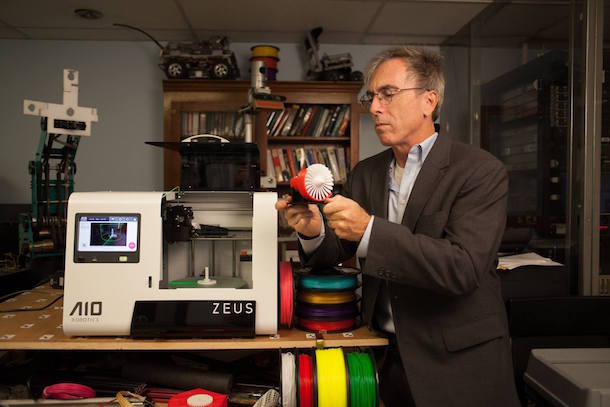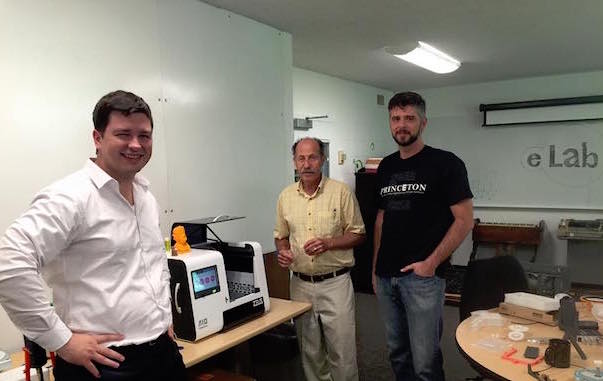
Every early-stage startup faces a unique set of hurdles standing between them and success. For 3D printing startup AIO Robotics, the challenge was finding a way to make an existing, complicated device simple enough for anyone to use.
Founded by three computer science students at USC, the team came together while tinkering with 3D printers on campus. As the trio became more familiar with the strengths and weaknesses of the printers they were working with, it was clear there was potential to exploit a significant gap in the burgeoning industry: not everyone could use the printers.
“We realized there was an opportunity in the market to build the world's first all-in-one 3D printer, one which had a lot more functionalities than existing printers at the time,” said Jens Windau, founder and CEO. “We integrated a 3D scanner into the printer, an onboard computer and a big touchscreen and made it a full stand-alone device that, at the time, was the only one in the market, and still pretty much is. That’s when we started working on the business side.”
Product in hand, the team had another problem: they didn't know anything about starting a business. In the summer of 2013, they joined the USC Viterbi Startup Garage, an incubator program dedicated to serving current and former Trojans as they begin to navigate the startup world. While taking part in the program, the team gathered valuable business insight, as well as fine-tuned their printer, ZEUS.
While the unit's touchscreen and onboard computer make operation easy, it's the apps AIO Robotics creates which make it unique. The AIO Robotics team is constantly developing apps for specific scenarios, like one that allows students to easily design and print parts for their robotics class, or one that helps medical professionals design and print prosthetics.
“Our initial vision equips every household with a 3D printer, but we very quickly realized that 3D printers aren't advanced enough yet for someone to wake up and print a plastic plate for breakfast,” said Windau. “3D printers will eventually become that mainstream where anyone can use one on a daily basis, but we knew to succeed we had to address the printer to specific target markets. Now our vision is to bring our printers into every school out there, and equip small-to-medium sized businesses with 3D printers to help them with small-batch production.”
While taking part in USC’s incubator program, AIO Robotics launched a Kickstarter campaign to grow brand awareness and help develop deals with manufacturers. It worked, and the 2013 campaign helped them raise awareness and eventually helped them secure additional angel investments.
“It's quite hard for an early-stage startup to raise the necessary capital to get the manufacturers excited,” said Windau. “For us, the Kickstarter campaign wasn't just fundraising, it was also getting the attention from manufacturers and customers, so it was a big marketing tool for us.”

With $110,000 raised from the Kickstarter campaign, the company built out their logistics process and grew a team of tech support professionals. Since then, they have raised additional angel funding, moved to their headquarters in Brentwood, and the number of local employees has swelled to 10.
In their three years of operation, sales have doubled each year, and as awareness grows, Windau said the focus is on growing the company’s logistical capabilities to keep up with demand. To do so, Windau and his founders are seeking an additional round of funding.
“Our demand outgrew our manufacturing capacity pretty quickly, so we need to invest in special tooling in order to have a higher output on the manufacturing side,” said Windau. “We also want to invest in new IT. We have some exciting new technologies coming out and we're in the process of patenting and preparing to manufacture."
In growing awareness for their brand, AIO Robotics is also helping people understand the capabilities of 3D printing more generally.
“We meet groups of people who aren’t in touch with 3D printers and you can see it in their eyes how happy they are to learn about this new technology, and it's really cool to see,” said Windau. “When you hear about doctors' offices building prosthetic devices with 3D printers, it doesn't take very long to educate people out there about the useful applications of 3D printers. I think five years from now, it will be a standard technology integrated in everyone's life.”
Images via Facebook
Have a news tip for us or know of a company that deserves coverage? Let us know and follow us on LinkedIn.






